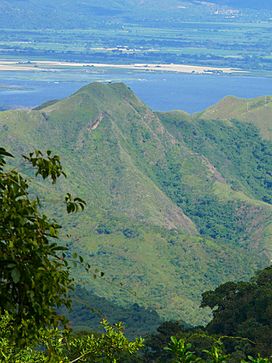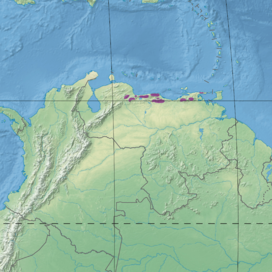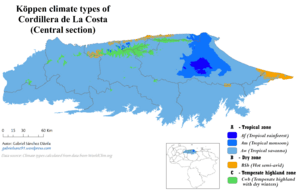Cordillera de la Costa montane forests facts for kids
Quick facts for kids Cordillera de la Costa montane forests (NT0117) |
|
|---|---|

View from Henri Pittier National Park
|
|

Ecoregion territory (in purple)
|
|
| Ecology | |
| Realm | Neotropical |
| Biome | tropical and subtropical moist broadleaf forests |
| Borders | Araya and Paria xeric scrub, La Costa xeric shrublands and Lara–Falcón dry forests |
| Geography | |
| Area | 14,245 km2 (5,500 sq mi) |
| Country | Venezuela |
| Coordinates | 10°34′16″N 66°38′17″W / 10.571°N 66.638°W |
| Climate type | Aw equatorial, winter dry |
The Cordillera de la Costa montane forests are a special type of forest found on mountains. This area is an ecoregion, which means it's a large natural area with its own unique plants and animals. It's located in the Venezuelan Coastal Range along the Caribbean Sea in northern Venezuela. These forests are known for being moist and having many broadleaf trees, meaning trees with wide, flat leaves.
Contents
Where are these forests?
The Cordillera de la Costa montane forests stretch across several separate mountain areas along the coast. They cover about 1.4 million hectares (which is like 3.5 million acres!).
Most of these forest areas are surrounded by drier lands called La Costa xeric shrublands. To the west, they meet the Lara–Falcón dry forests. The two parts furthest to the east are surrounded by the Araya and Paria xeric scrub.
What is the land like?
This ecoregion has eleven separate sections, located at different heights, from about 600 to 2,675 meters (2,000 to 8,776 feet) above sea level.
The Venezuelan Coastal Range is actually two mountain chains that run side-by-side across northern Venezuela. They separate the Orinoco River basin in the south from the Caribbean Sea in the north. This mountain range is an extension of the famous Andes Mountains. These moist forests are like green islands, surrounded by drier shrublands and the huge Llanos grasslands of the Orinoco basin.
What is the climate like?
Most of this region has an "equatorial, winter dry" climate. This means it's warm all year round, but has a dry season in winter. In the higher parts of the mountains, the climate changes to "warm temperate, winter dry." This means it's still warm, but not as hot as the lower areas, and it also has a dry winter.
What plants grow here?
This ecoregion is home to three main types of plant groups, depending on how high up they are and how much sunlight and wind they get. These are:
- Evergreen transition forests
- Evergreen montane cloud forests
- Upper montane elfin forest
Evergreen transition forests
These forests are found at elevations from about 600 to 1,000 meters (2,000 to 3,300 feet). They grow above the drier forests of the La Costa xeric shrublands. These transition forests have a dense top layer of trees, called a canopy. Some common trees here include Trophis racemosa and Ficus macbridei.
A very special giant tree called Gyranthera caribensis can grow up to 60 meters (200 feet) tall! It stands out above the rest of the forest. Below the main trees, the understory (the layer of plants growing under the canopy) has woody shrubs, ferns, and large plants like Heliconia bihai.
Evergreen montane cloud forests
These forests are found higher up, from 1,000 to 2,000–2,400 meters (3,300 to 7,900 feet). They are the richest in different plant species in the whole ecoregion. The trees here form a closed canopy about 15–20 meters (50–65 feet) high.
Palm trees are very common, both in the canopy and below it. These forests have a thick understory of shrubs, herbs, and ferns. Many trees are covered with epiphytes. These are plants like ferns, orchids, and bromeliads that grow on other plants, but don't harm them.
Upper montane elfin forest and scrub
Even higher up, above 2,000–2,400 meters (7,900 feet), you'll find the upper montane elfin forest. This area has low, mossy forests with small, dwarfed trees. Some trees found here include Clusia multiflora and Weinmannia species. There are also open areas with scrublands, where plants like Libanothamnus neriifolius grow.
What animals live here?
This ecoregion is home to many amazing animals, including some that are endangered.
Some endangered amphibians (like frogs and toads) found here are:
- Allobates mandelorum
- Atelopus cruciger
- Gastrotheca ovifera
- Hyalinobatrachium pallidum
Endangered birds include:
- Venezuelan flowerpiercer (Diglossa venezuelensis)
- Scissor-tailed hummingbird (Hylonympha macrocerca)
- Paria whitestart (Myioborus pariae)
- Helmeted curassow (Pauxi pauxi)
- Red siskin (Spinus cucullatus)
- Black-and-chestnut eagle (Spizaetus isidori)
Protecting these forests
The World Wildlife Fund (WWF) says that this ecoregion is "Vulnerable." This means it's at risk and needs protection.
Luckily, some parts of these forests are protected areas. These include the Macarao National Park and the Henri Pittier National Park. These parks help keep the unique plants and animals safe.
See also
 In Spanish: Bosques montanos de la Cordillera de la Costa para niños
In Spanish: Bosques montanos de la Cordillera de la Costa para niños


